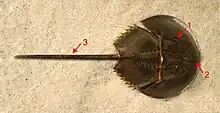尾節
尾節(英語:),又稱尾柄,為節肢動物身體分節的最末節,沒有附肢也沒有神經節,因此並不是真正的體節。不同類群的節肢動物其尾節的形狀與用途不盡然相同。

白濱對蝦的示意圖,以橘色標示其尾節位置

圓尾鱟的尾節(標記為3者)
甲殼亞門
海螯蝦、真蝦下目與其他十足目的成員,其尾節與尾肢合併形成尾扇,透過快速搧動尾扇,可以以極高的速度向後彈開逃跑。透過此形式,磷蝦可以60 公分/秒的速度逃離掠食者。從感受到刺激至觸發行為,就算在低溫下也僅僅需要55 毫秒。
多足亞門

倍足綱的尾節,包含了肛上板(e)、肛下板(h)與肛側板(p)
倍足綱的尾節由肛門前無足的體節(肛上板)與一對肛側板以及肛下板組成,將肛門完整包覆[2][3]。
唇足綱的尾節為最後一節體節,具有尾柄,還有一個生殖器官的開口[4]。
參考文獻
- S. J. Keable, G. C. B. Poore & G. D. F. Wilson. . Australian Museum. October 2, 2002 [2018-08-05]. (原始内容存档于2018-10-10).
- Sierwald, Petra; Bond, Jason E. . Annual Review of Entomology. 2007, 52 (1): 401–420. PMID 17163800. doi:10.1146/annurev.ento.52.111805.090210.
- Mesibov, Robert. . External Anatomy of Polydesmida. [4 November 2013]. (原始内容存档于2017-08-10).
- Lewis, J. G. E. Digitally printed 1st paperback version. Cambridge: Cambridge University Press. 2008. ISBN 9780521034111.
This article is issued from Wikipedia. The text is licensed under Creative Commons - Attribution - Sharealike. Additional terms may apply for the media files.
